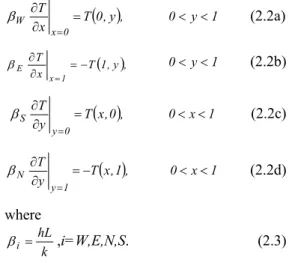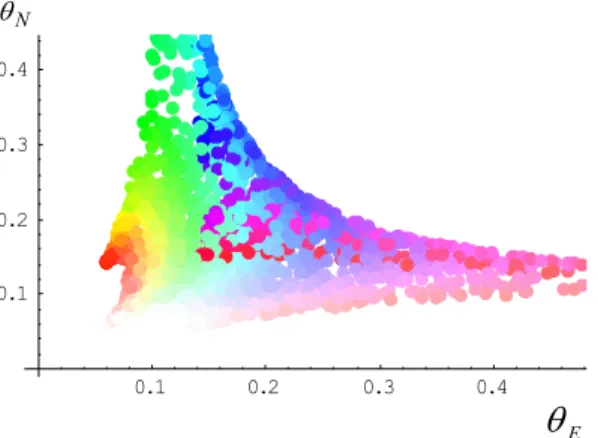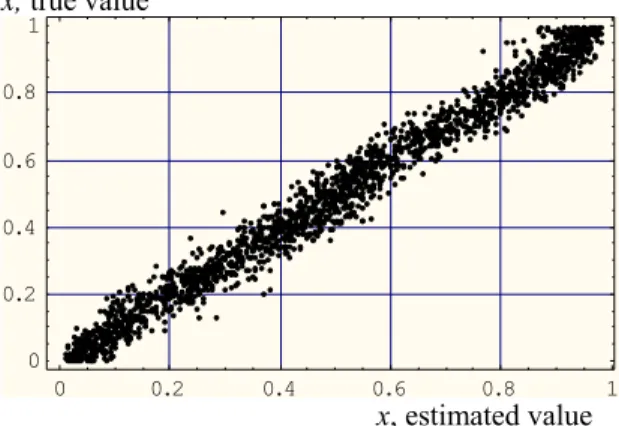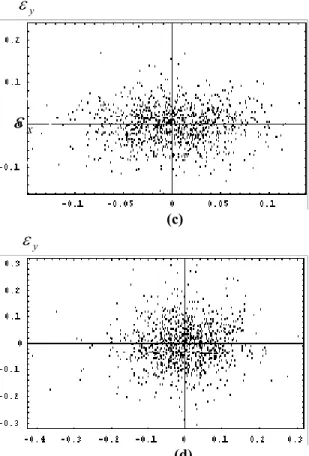Received Date :19.09.2004
ON THE INVERSE POINT-SOURCE PROBLEM OF THE
POISSON EQUATION
1
Melek YILMAZ
2Metin ŞENGÜL
3Melih GEÇKİNLİ
1,2Faculty of Engineering, Kadir Has University, Cibali-Fatih 34083 Istanbul, Turkey 3Institute of Energy, Istanbul Technical University, Maslak 34469 Istanbul, Turkey 1E-mail: myilmaz@khas.edu.tr 2E-mail: msengul@khas.edu.tr 3E-mail: geckinli@itu.edu.trABSTRACT
In this work, a basic inverse heat conduction problem of a simple 2-D model with steady state heat source is taken into view. The physical problem is for a square region with uniform thermophysical properties and a point heat source of unit magnitude. To obtain boundary data , temperature probes are placed at the midpoints of the sides of the square domain. The objective of the inverse problem is to estimate the coordinates of the point source with the least amount of data. Initially, the inverse problem is analyzed to determine the main causes that render the problem ill conditioned. As for the solution, among the methods that has been tried so far, the best results are obtained from a backpropagating ANN with four-probe data. When white Gaussian noise is added to the measurements, no catastrophic failure has been observed.
Keywords: Inverse heat conduction problem, poisson equation, artificial neural networks, self organizing maps
1. INTRODUCTION
Inverse problems are encountered in various fields of the computational mathematical physics and with the advent of new solution techniques have been attracting the attention of researchers. In some cases it is systematically by nature of the problem per se, such as computed tomography; in others it arises from some technical problems. The behaviour of most physical systems can be mathematically modelled as well-posed problems, [1-6]. This is true just because such physical systems have certain common characteristics; spatio-temporal low-pass filtering properties being the top item of that list. From
this observation it immediately follows that the associated inverse problems are necessarily based on high-pass models, which in principle tend to amplify the high frequency noise components of the measured input data, and this is obviously contrary to what we get used to. In other words, the difficulty is that the inverse problem is extremely sensitive to measurement errors which results in the instability of the solution. Another flaw of the inverse problem stems from the fact that the solution of the forward problem may correspond to a situation in which several distinct points of the input space are mapped onto the same point of the output
space, which violates the uniqueness requirement of the well-posedness, at least locally.
The regularization method is a remedy to the adverse high-pass property of the time dependent inverse problem combined with the nonuniquness of the solution. As for the steady state problems judicious selection of measurement points might be helpful in rendering a well posed inverse problem [6]. A brief overview of the generic applications of inverse methods in engineering is given in Ch.13 of [2]. Inverse source problem of the Poisson equation is chiefly used in determining dipole current source in the brain and the heart [7]. Electrical source imaging (ESI) is an emerging technique for reconstructing brain or cardiac electrical dipole current activity from electrical potential measured by the electrodes placed on the skin, which is a substantial improvement upon the classical diagnostics.
Although there are certain well established generic forms of the regular heat conduction problem, there is no such classification of inverse heat conduction problems (IHCP); rather circumstances dictate the formulation [8-11]. Neural network approach is rather rarely used in the solution of IHCP. In this work, we address the simplest case of inverse source problem of the Poisson equation –namely, estimation of point source coordinates from measured boundary data-with the aid of backpropagating feedforward artificial neural networks.
2. THE PHYSICAL PROBLEM
Our conduction problem consists of a unit square region of homogeneous thermophysical properties. Homogeneous boundary conditions of the third kind are applied to the periphery of the region. A steady point source is located somewhere inside the square. Temperature probes are placed at the midpoints of the all four sides of the medium, Fig.1. The formulation of the problem is stated below in the conventional notation:
( )
x,y, T k∇2 =−ρ 0<x<1, 0<y<1 (2.1) Point source: ). y y ( ) x x ( k / ) y , x ( =δ − o δ − o ρ Boundary conditions( )
0,y, T x T 0 x W ∂∂ = = β 0<y<1 (2.2a) ( )1,y , T x T 1 x E ∂∂ =− = β 0<y<1 (2.2b)( )
x,0, T y T 0 y S ∂∂ = = β 0<x<1 (2.2c)( )
x,1, T y T 1 y N ∂∂ =− = β 0<x<1 (2.2d) where k hL i= β ,i=W,E,N,S. (2.3) Here, T(x, y ), k, h, L(=1) are the local temperature, thermal conductivity of the medium, convective heat transfer coefficient, and the length of the side of the square region, respectively.The solution of the direct problem is given in normalized coordinates as:
∫ ∫ =1 0 1 0 dv du ) v , u ( ) v , u ; y , x ( G ) y , x ( T ρ , (2.4)
where the Green’s function of the problem is constructed as a series in terms of the eigenfunctionsϕi(x) and eigenvalues λ of the i related one dimensional homogeneous problem which results from the separation of variables:
(
)
∑ ∑( ) ( ) ( ) ( )
(
)
+ − = j i 2i 2j 0 j 0 i j i 0 0 y x y x y , x ; y , x λ λ ϕ ϕ ϕ ϕ G (2.5)Fig. 1. Geometry of the heat conduction problem;θi represent the pointwise boundary temperature measurements point source at
+
(xo, yo) _ θE N θ | W θ _ | S θx
y
1 0 1 0 T∞ = T(x,y)Now we elaborate upon the associated inverse problem. For a given point source located at (xo,yo), we may calculate/measure the boundary
temperature data, say (θE,θN). Direct heat conduction problem is considered as a mapping; DHCP: (xo,yo)→(θE,θN) which is not invertible. Fig. 2 shows the randomly selected source coordinates from a uniform joint probability density function. Fig. 3 gives the corresponding mapping to(θE,θN) space. It is easy to demonstrate the noninvertibility of the mapping. In order to surmount this difficulty, we increase the dimensionality of the measured data set to four.
3. SOLUTION
In this work we intend to test some of the emerging methods to attack the inverse problem. Self-organizing mapping (SOM) method, [13], seemed to be one of the simplest approaches worth trying. SOM consists of neural elements distributed on a regular lattice. Θvectors are fed for training , and a fading Gaussian neighborhood function is used. When trained, for a particular Θvector, the physical position of the firing (or winning) neuron is expected to represent approximately the position of the corresponding point source. Unfortunately the problem proved to be too hard for the SOM to learn. It did not yield reasonable results because the original X→Θ2 mapping do not preserve the topology and we surmise that the same is true forX→Θ4mapping. y 0.2 0.4 0.6 0.8 1 0.2 0.4 0.6 0.8 1 x
Fig. 2. a) Point sources picked from uniform probability density on a square.
N θ 0.1 0.2 0.3 0.4 0.1 0.2 0.3 0.4 E
θ
Fig. 2. b) Corresponding mapping onto Θ2 spaceNext in line comes the artificial neural networks [12,13]. In the hidden layer tanh and in the output layer unipolar sigmoid are used as activation functions. Paralysis of the nodes due to saturation has been taken care of. For training and validation purposes a data set of 2000 is generated randomly. Half of the data set is set aside for on line validation tests. Training was halted at the moment the learning stopped and memorizing began. Backprop ANN with 2x10x2 layer structure could not learn the inverse mapping:
θ
2→
X
for obvious reasons. ANN with 4x10x2: θ4→Xproduced reasonable results. In order to test the robustness of the ANN, the training set was extended by adding white Gaussian noise to measurement data with% 20 , 10 , 5 =
σ . Training session takes about
75000 epochs with exact data whereas it may take up to 200000 with noise- corrupted data sets. Results are graphically displayed in Fig. 3 through 10. x, true value 0 0.2 0.4 0.6 0.8 1 0 0.2 0.4 0.6 0.8 1 x, estimated value
Fig. 3. Validation performance of the ANN trained with exact measurements and tested with the same sort of data
x, true value 0 0.2 0.4 0.6 0.8 1 0 0.2 0.4 0.6 0.8 1 x, estimated value
Fig. 4. Validation performance of the ANN, trained with exact measurements but tested with noise-corrupted data(σ =5%) x, true value 0 0.2 0.4 0.6 0.8 1 0 0.2 0.4 0.6 0.8 1 x, estimated value
Fig. 5. Validation performance of the ANN, trained with exact measurements but tested with noise-corrupted data(σ =10%) x, true value 0 0.2 0.4 0.6 0.8 1 0 0.2 0.4 0.6 0.8 1 x, estimated value
Fig. 6. Validation performance of the ANN, trained with exact measurements and tested with noise-corrupted data(σ =20%) x, true value 0 0.2 0.4 0.6 0.8 1 0 0.2 0.4 0.6 0.8 1 x, true value
Fig. 7. Validation performance of the ANN, trained with noise-corrupted measurements (σ =5%) and tested with the same sort of data x, true value 0 0.2 0.4 0.6 0.8 1 0 0.2 0.4 0.6 0.8 1 x, estimated value
Fig, 8. Validation performance of the ANN,
trained with noise-corrupted measurements(σ =10%) and tested with the
same sort of data x, true value 0 0.2 0.4 0.6 0.8 1 0 0.2 0.4 0.6 0.8 1 x, estimated value
Fig. 9. Validation performance of the ANN,
trained with noise-corrupted measurements(σ =10%), but tested with exact
x, true value 0 0.2 0.4 0.6 0.8 1 0 0.2 0.4 0.6 0.8 1 x, estimated value
Fig. 10. Validation performance of the ANN, trained with noise corrupted measurements(σ =10%), but tested with another set of noise-corrupted data(σ =5%)
In Fig.11-a,b,c,d , it can be seen that the estimation error of the ANN which is trained with non-noise measurements, but tested with (
σ
=0, %5, %10, %20 ) noise corrupted data, respectively.ε
y (a)ε
y (b)ε
y (c)ε
y (d)Fig. 11. Distribution of estimation error (ANN trained with exact data ) tested a) by the same sort of data, b) by noise-corrupted data (
σ
=5%)c) by noise-corrupted data (
σ
=10%) d) by noise-corrupted data (σ
=20%)In Table 1 and 2, the performance of the ANN versus corrupting noise is displayed.
Table 1. Effect of measurement noise on the performance of the ANN(in terms of
σ
values)Noise added to test data
→
Noise added to training data↓
% 0 % 5 % 10 % 20 % 0 0.0223 0.0333 0.0627 0.1300 % 5 - 0.0302 - - % 10 0.0250 0.0345 0.0611 - xε
Table 2. Percentage of results which are within an acceptable error of 10% Noise added to test data
→
Noise added to training data↓
% 0 % 5 % 10 % 20 % 0 99 99 89 55 % 5 - 99 - - % 10 99 99 89 -4. RESULTS AND DISCUSSION
From the training experiments described above it is concluded that ANN cannot learn when the inverse mapping is not unique. By increasing the dimensionality of the boundary data uniqueness or invertibility is achieved and hence the ANN can be expected to learn the inverse problem. Initially ANN is trained and tested with the exact data to demonstrate the capability of the ANN, Fig. 3. Deviation from linearity increases at the edges due to Gibbs phenomenon spoiling the numerical results , Eqs. (2.4,2.5). As the additive noise level of the input data is increased the noise level of the results behave similarly, Fig. (4-6). From Fig. (7-10), we can conclude that ANN trained with noise-corrupted data perform reasonably better with the exact data than vice versa. This is due to the jitter which inherently provides some sort of regularization during the learning process [12].
5. CONCLUSION
We took on the simplest case of inverse heat conduction problem, namely the estimation of coordinates of the point source of a 2-D Poisson equation with the aid of artificial neural networks. It was observed that ANN fails gracefully in the face of measurement data corrupted with additive white Gaussian noise. Application of SOM did not yield reasonable results because the topology nonpreserving nature of the problem. The ANN approach could be further generalized by considering distributed source configurations. Time dependent sources can be handled with recurrent neural networks as well.
REFERENCES
[1] Özışık M.N., Orlande H.R.B., Inverse Heat Transfer:Fundamentals and Applications, Taylor & Francis, 2000.
[2] Kurpisz K., Nowak A.J., Inverse Thermal Problems, Computational Mechanics Publications, Southhampton, UK, 1995.
[3] Hensel E., Inverse Theory and
Applications for Engineers, Prentice-Hall, 1992 [4] Engl H.W., Hanke M., Neubauer A., Regularization of Inverse Problems, Kluwer Academic Publishers, Dordrecht, 2000.
[5] Alifanov O.M., Inverse Heat Transfer Problems,Springer-Verlag, 1994.
[6] Hensel E., Inverse Theory and
Applications for Engineers, Prentice Hall, 1991. [7] Gencer N.G., Tanzer I.O.,”Forward Problem Solution of Electromagnetic Source Imaging Using a New BEM Formulation with High-Order Elements”,Phys. Med. Biol.,Vol. 44 ,pp. 2275–2287, 1999.
[8] Kim S.K., Lee W.I., “Solution of Inverse Heat Conduction Problems Using Maximum Entropy Method”, Int. J. Heat Mass Transfer, Vol.45, pp.381-391, 2002.
[9] Huang C.-H., Cheng S.-C., “A Three-Dimensional Inverse Problem of Estimating the Volumetric Heat Generation for a Composite Material”, Numerical Heat Tr. Part A, Vol. 39, pp. 383-403, 2001.
[10] Huang C-H, Chin S-C, “A Two-Dimensional Inverse Problem in Imaging the Thermal Conductivity of a Non-Homogeneous Medium”, International Journal of Heat and Mass transfer, Vol. 43, 2000.
[11] Chan H.-T., “Estimation of Surface Temperature in Two-Dimensional Inverse Heat Conduction Problems”, Int. J. HeatMass Tr. Vol. 44, pp. 1455-1463, 2001.
[12] Reed R.D., Marks R.J., Neural Smithing: Supervised Learning in Feedforward Artificial Neural Networks, The MIT Press, 1999.
[13] Haykin S., Neural Networks: A Comprehensive Foundation, 2nd ed., Prentice
Hall International, 1999.
Melek Yılmaz was born in Istanbul on July 23, 1978. She received her B.S. degree in Physics Engineering and her M.S. degree in Nuclear Energy Institue from Istanbul Technical University in 2000 and 2004, respectively. She is a PhD student at Istanbul Technical University at Physics Engineering Department. Since 2000, she is working at Kadir Has University Engineering Faculty as a research assistant.
Metin Şengül was born in Bartın on November 04, 1971. He received his B.S. and M.S. degrees in Electronics Engineering from Istanbul University in 1996 and 1999, respectively. He is a PhD student at Işık University at Electronics Engineering Department. He worked at Vocational School of Technical Science, Istanbul University, as an electronics technician from 1990 to 1997. Then, he worked at Prime Ministery as a design engineer from 1997 to 2000. Since 2000, he is a lecturer at Kadir Has University Engineering Faculty.
Melih Geçkinli is working at Energy Institue-Nuclear Research Division of Istanbul Technical University.




